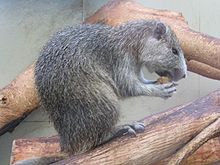Hystricognathi
| Hystricognathi Temporal range:
| |
|---|---|

| |
Capromys pilorides
| |
| Scientific classification | |
| Domain: | Eukaryota |
| Kingdom: | Animalia |
| Phylum: | Chordata |
| Class: | Mammalia |
| Order: | Rodentia |
| Suborder: | Hystricomorpha |
| Infraorder: | Hystricognathi Tullberg, 1899 |
| Families | |
|
Abrocomidae Bathyergidae † Bathyergoididae Capromyidae Caviidae †Cephalomyidae Chinchillidae Ctenomyidae Cuniculidae Dasyproctidae †Diamantomyidae Dinomyidae Echimyidae †Eocardiidae Erethizontidae †Heptaxodontidae Heterocephalidae Hystricidae †Kenyamyidae Myocastoridae †Myophiomyidae †Neoepiblemidae Octodontidae Petromuridae †Phiomyidae Thryonomyidae | |
| Synonyms | |
|
Eucaviomorpha | |
The Hystricognathi are an
masseter medialis (a jaw muscle) passes partially through a hole below each eye socket (called the infraorbital foramen) and connects to the bone on the opposite side. This, together with their lack of an infraorbital plate and the relative size of the infraorbital foramen
, distinguishes hystricognaths from other rodent groups.
The 18
North America, while the Phiomorpha occur in the Old World
.

Behavior
Play behavior has been observed in seven hystricognath families. The caviomorphs chase each other, play-wrestle, and gallop. The longer-legged species chase more often than the shorter-legged species. They also rotate their heads and body muscles as a form of play.[1]
Phiomorphan hystricognath families
- Bathyergidae(African mole rats)
- monotypictaxon)
- Hystricidae(Old World porcupines)
- monotypictaxon)
- Thryonomyidae (cane rats)
Caviomorphan hystricognath families
- Abrocomidae(chinchilla rats)
- Capromyidae(hutias)
- Caviidae (guinea pigs, wild cavies, and capybaras)
- Chinchillidae (chinchillas and viscachas)
- Ctenomyidae(tuco-tucos)
- Cuniculidae(pacas)
- Dasyproctidae (agoutis and acouchis)
- megafaunal size)
- Echimyidae (spiny rats)
- Erethizontidae(New World porcupines)
- Myocastoridae(coypu)
- Octodontidae (13 species including the degus)
See also
References
Citations
- ^ Fagen, Robert. Animal Play Behavior. Oxford University Press, 1981.
Sources
- Alfred L. Gardner Curator of North American mammals and Chief of Mammal Section, National Biological Service,Smithsonian Institution, National Museum of Natural History, Washington, DC, USA
- Charles A. Woods Florida Museum of Natural History, University of Florida, Gainesville, FL 32611-2035
- ISBN 0-231-11012-X
- Wilson, Don E., and DeeAnn M. Reeder, eds. 1993 Mammal Species of the World: A Taxonomic and Geographic Reference, 2nd ed., 3rd printing xviii + 1207 Smithsonian Institution Press Washington, DC, USA ISBN 1-56098-217-9Corrections were made to text at 3rd printing
